The Saint Paul Police Crime Lab:
An Evolution In Forensics
by
Edward J. "Ed" Steenberg
Saint Paul Police Historical Society
Part III: The Division of Criminal Identification

While we do not know the actual date of the startup of the first Saint Paul Police identification unit, the earlier mentioned departmental manual from 1882 states under "Rules and Regulations No. 16" that when any person is taken into custody by the officers detailed at the central office, he shall, if practicable, be conveyed to that office, and a full description of his person, and the time and cause of his arrest, his name, and that of the arresting officer, with the amount and description of property taken from his person, shall be recorded on the book kept for that purpose. The property taken from any person shall be put together, carefully marked and left with the chief of police. As mentioned earlier, several of these daily ledgers and arrest logs are on display in the Saint Paul Police Historical Society museum located on the second floor of the Griffin Building (downtown police headquarters).
Chicago was the first American policing agency to assemble an official and organized "Rogues' Gallery" in 1884 15, followed shortly thereafter by Scotland Yard, in London. Although the police in Saint Paul had been collecting photos for many years prior thereto, in April of 1897 the common council made an appropriation for the purchase of what would be the city's first rogues' gallery cabinet 16 with a capacity of 1,536 pictures. Over 500 photos were by now ready for display, with exchanges with other agencies expected in the near future.
In several instances, reference was made of the rogues' gallery in Saint Paul Police daily ledgers, arrest logs, and court records from the late 1800s. As well, Saint Paul City Comptroller Reports from the same period show several instances of "Criminal Identification" expenditures being made, including that for rogues' gallery operating costs.
A departmental manual from 1923 documents a Division of Criminal Identification commanded by a Superintendent, working under the direction of the Chief of Police. He was to have full control of all matters pertaining to the taking of photographs, finger prints, Bertillon and other measurements of criminals, and the securing of their records. All persons arrested and held for Criminal Court on felony charges were to be taken to the Division of Criminal Identification by the arresting officer for processing.
For a job description of the early 20th Century "Criminal Identification Superintendent", and more, go to Manual of the St. Paul Police Department; 1923, on our Saint Paul Police Historical Society website.

The Bertillon System of Identification
SPPD Circa 1890
One of the first big changes in criminal investigations came about with the "Bertillon System of Identification", which was an improvement over simple mug shots and basic physical descriptors, and was a forerunner to fingerprinting, and now to deoxyribonucleic acid (D.N.A.) testing. It was developed by French criminologist Alphonse Bertillon 17 in the early 1880s to increase the accuracy of criminal identification by measuring certain bony portions of the body, including the skull, foot, cubit, trunk and left middle finger. This identification method spread throughout Europe and was introduced into the United States in 1887.
Although photographs had been taken and basic descriptions documented for many years, on January 1, 1901, the Bertillon System of Identification was in full operation in the Saint Paul Police Department, including front and profile photographs. According to The St. Paul Globe 18, this innovation brought the Detective Bureau on par with the leading criminal agencies of the civilized world. For its time, Saint Paul's Police Department was well-equipped. The Bertillon cards with photographs were available not only to police personnel, but they were also open to the public for viewing. At the same time, the department became a member of the National Bureau of Identification 19, a distribution system not unlike that of today's digital networks, which included federal and state prisons and every police agency of any importance in the civilized world. Thus, this was a rogues' gallery on a more systematic basis and instead of simple in-house exchange, the criminal history records would be circulated by telegraph to all members of the national bureau. The N.B.I., also known as the National Criminal Bureau of Identification ceased to exist as an independent organization when it was absorbed by the Federal Bureau of Investigation (F.B.I.) in 1924.
Although the Bertillon System of Identification was accepted worldwide, mistakes were made. Saint Paul was one of the few agencies in the United States whose Bertillon records were accepted as "absolutely trustworthy", but by late 1904 police agencies were already starting to look at fingerprinting as a replacement for the Bertillon System 20.
On April 14, 1906, the first time since the New York City Police Department began experimenting with fingerprints as identification marks of criminals, as exploited by Mark Twain in the tale of "Pudd'nhead Wilson" 21, a practical test was conducted identifying one Henry Johnson as the perpetrator of several bold robberies in their city 22. In that he was possibly involved in the same type of criminal activity in London, England, his prints were sent to the London police where they had his prints on record. England had already adopted the fingerprint system as the primary form of identifying criminals. And by 1912, many of the larger American cities were starting to fingerprint newborn babies and abandoned infants, in place of footprints. 23
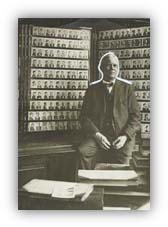
Saint Paul Police Bertillon Room
Circa 1924
One of the more colorful members of the Saint Paul Police Department during the 1920s was a detective by the name of James C. Murnane 24. Detective Murnane, who had a national reputation as a Bertillon expert, was in charge of the Department's Division of Criminal Identification. He was said to have studied 100,000 of 130,000 records in the Bertillon room during the course of 25 years of service. During a test of his prowess he repeated, without mistake, the names and records of 700 men who were chosen from the gallery.
The Minnesota History Center, located at 345 W. Kellogg Blvd. in Saint Paul, has a collection in alphabetical order, of 125 mug shots and 85 Bertillon cards 25 which originated with, or were used by the Saint Paul Police Department 26, and documents the identification and incarceration of criminals in the city from 1891 through 1911. "House Sneak," "Safe Blower," and "Swindler" were not uncommon criminal occupations, and tattoos, scars, moles and physical shortcomings were duly noted. One card in the collection describes a criminal as follows: "Walks slightly pigeon-towed, slightly stooped shoulders, round lump on the top and back of head…" .
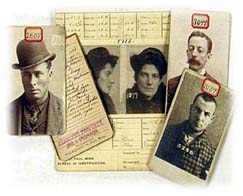
Mug Shots & Bertillon Cards
SPPD Circa 1890
Of added interest, the Bertillon cabinets utilized by the police department to store the thousands of identification cards and photos were built by the students from Saint Paul's Mechanic Arts High School. They also 'turned' the department's night sticks, and manufactured the city's mechanical traffic signals prior to the advent of electric traffic lights. A sample of said mechanical traffic signal can be seen on display in the Western District's lobby.
For more information on the Bertillon System of Identification, go to The Bertillon System of Identification, and to History of the Police and Fire Departments of the Twin Cities, 1899, on our Saint Paul Police Historical Society website.
During the first 50 years of the department's existence horses and officers' legs provided the necessary locomotion for police work. However, with the advent of the automobile in the early 20th century, another mode of transportation became a reality -- the motorized vehicle.
The motorization of the department dates back to 1912 when a White Motor Company (Cleveland, Ohio) squad wagon and a Chalmers Motor Company (Detroit, Michigan) five-passenger touring car was acquired, and soon thereafter a motorized police ambulance. It was not until 1914, however, that the department purchased automobiles specifically suited for police work -- a Velie Motors Corporation "Runabout" (Moline, Illinois), a White Motor Company (Cleveland, Ohio) police patrol and two Kissel Motor Car Company (Hartford, Wisconsin) police patrols. These were predecessors of the current fleet.
A highbred of the original White squad wagon is what became known as the "Emergency Car". It was large enough to carry equipment for crime scene processing, as well as transporting most evidence back to headquarters. It was also large enough to hold a collapsible stretcher and advanced first aid equipment so that it could be a backup for the police ambulance. The emergency cars were designated as zone cars, and would cover multiple squad districts, responding to routine police calls, as well as the unusual. The officers received special training in both crime scene processing and advanced first aid. Today, they are often referred to as, simply, the camera car and whereas they originally backed up the Division of Criminal Identification, today they back up the Forensic Services Unit, while providing extra officers for squad patrol.
 |
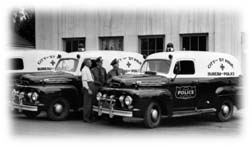 |
|
| Police Ambulance & Emergency Car SPPD Circa 1915 |
Police Emergency Cars SPPD Circa 1952 |
With the advent of the Police Laboratory in 1935, specialized vehicles were designed specifically for use as mobile crime labs.
According to the record of research by prominent criminalists, the individuality of the finger print (visible/impression/latent) and its value in proving identity was discovered by the Chinese over 200 years before the Christian era 27. Later this method was also adopted in India, and while from time to time various systems for the classification of impressions were advanced, they were not seriously considered until the English government, realizing its value, adopted the "Henry System" in 1901. Since then finger prints have been collected and classified by the police departments of all principal cities throughout the world.
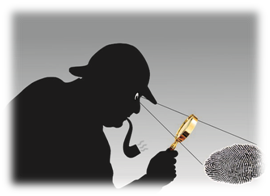
The Henry Finger Print System
SPPD Circa 1917
The Saint Paul Police Department officially adopted the Henry Finger Print System in October of 1917, in connection with the Bertillon System, the latter system having been used by the department for some sixteen years. A clipping appearing in the St. Paul Daily News exclaimed that everyone arrested by the police would be fingerprinted and otherwise recorded at Central Station and the records sent to outlying sub-stations. This enlargement of the police Bureau of Identification would include a rogues' gallery and a records keeping function for each of the police sub-stations. This plan would allow police in outlying stations to study pictures and fingerprints, and noted criminals arrested on minor charges would stand less chance of escaping by payment of small bail.
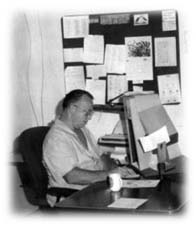
John Kinderman at work at
his Identification Unit work station.
SPPD Circa 1990
The Saint Paul Police maintained its own Identification Unit until mid-1994, although the Ramsey County Sheriff's Department had taken over the operation of the city jail located at the Public Safety Building back in 1972. Sworn officers from the unit processed all prisoners booked into the jail, developed and maintained criminal history records, and conducted departmental "showups". 1977 saw the advent of a computerized program providing access to criminal history record information from the F.B.I., Minnesota B.C.A., and many other agencies participating in the program. Hmmm... sounds like the National Bureau of Identification (N.B.I.) from eighty years earlier.
If the introduction of fingerprint analysis revolutionized the identification of criminals in the early 1900s, the introduction of the Minnesota Automated Fingerprint Identification Network (M.A.F.I.N.) in 1979 made it much more useful as a crime fighting tool… the search and identification of fingerprints from crime scenes and of unidentified deceased.
For more information on The Henry Fingerprint System, go to Origin of Finger Prints; What They Are and How Used on our Saint Paul Police Historical Society website.
Part IV: The Crime Lab >>>
15 The St. Paul Daily Globe; Saturday, August 01, 1885, page 3.
16 The St. Paul Globe; Monday, March 01, 1897, page 2.
17 Alphonse Bertillon was a French police officer and biometrics researcher who applied the anthropological technique of anthropometry to law enforcement creating an identification system based on physical measurements.
18 The St. Paul Globe; Sunday, November 18, 1900, page 3.
19 The National Bureau of Criminal Identification (N.C.B.I.) also called the National Bureau of Identification was an agency formed by the National Chiefs of Police Union in 1896, and opened in 1897, to record identifying information on criminals and share that information with those in law enforcement.
20 The St. Paul Globe; Sunday, December 18, 1904, page 50.
21 Pudd'nhead Wilson is a novel by Mark Twain. It was serialized in The Century Magazine (1893-94), before being published as a novel in 1894. Young David Wilson had a hobby of collecting fingerprints, which became a part of a criminal proceeding, later in the book.
22 The Minneapolis Journal; Sunday, April 14, 1906, Part II, Editorial Section, page 3.
23 The Appeal; Saturday, August 03, 1912, page 2.
24 James C. Murnane was appointed Detective on June 3, 1896; was promoted to Lieutenant of Detectives on April 2, 1912; was appointed in charge of the Bertillon System on June 15, 1914; and died on June 29, 1921.
25 A listing of said Mug Shots & Bertillon Cards containing names and aliases can be found online at the Minnesota History Center website: www2.mnhs.org/library/findaids/SPaul041.xml.
26 The Mug Shots & Bertillon Cards were previously owned by Chief John J. O'Connor, and donated to the History Center.
27 The Chinese were the first culture known to have used friction ridge impressions as a means of identification. The earliest example comes from a Chinese document entitled The Volume of Crime Scene Investigation -- Burglary, from the Qin Dynasty (221 to 201 B.C.). The document contains a description of how handprints were used as a type of evidence.
